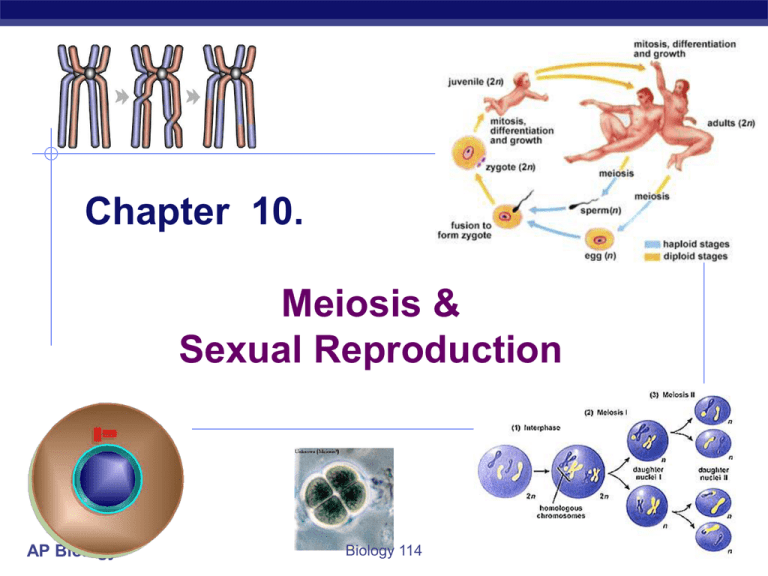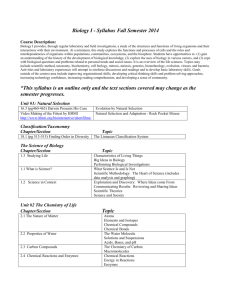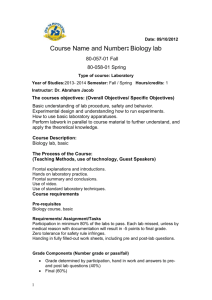AP Biology Chapter 10. Meiosis & Sexual - Environmental
advertisement

Chapter 10. Meiosis & Sexual Reproduction AP Biology Biology 114 Cell division / Asexual reproduction Mitosis produce cells with same information identical daughter cells exact copies clones same amount of DNA same number of chromosomes same genetic information AP Biology Aaaargh! I’m seeing double! Asexual reproduction Single-celled eukaryotes reproduce asexually yeast Paramecium Amoeba Simple multicellular eukaryotes reproduce asexually Hydra budding What are the disadvantages of asexual reproduction? AP Biology What are the advantages? Budding in Yeast Binary fission in Amoeba AP Biology How about the rest of us? What if a complex multicellular organism (like us) wants to reproduce? joining of egg + sperm Do we make egg & sperm by mitosis? 46 egg AP Biology + 46 92 sperm zygote Human female karyotype AP Biology Human male karyotype AP Biology How do we make sperm & eggs? reduce 46 chromosomes 23 chromosomes half the number of chromosomes 23 46 meiosis 23 46 egg 23 46 23 sperm AP Biology fertilization Meiosis: production of gametes Alternating processes, alternating stages chromosome number must be reduced diploid haploid 2n n humans: 46 23 meiosis reduces chromosome number fertilization restores chromosome number haploid diploid AP Biology n 2n Homologous chromosomes Paired chromosomes both chromosomes of a pair carry genes control same inherited characters homologous = same information diploid 2n AP Biology homologous chromosomes double stranded homologous chromosomes Sexual reproduction: Fertilization - 1 copy - haploid - 1n from Mom AP Biology from Dad - 2 copies - diploid - 2n Making gametes for the next generation - 2 copies - diploid - 2n We’re mixing things up here! AP Biology - 1 copy - haploid - 1n Meiosis = reduction division Meiosis special cell division in sexually reproducing organisms reduce 2n 1n diploid haploid half makes gametes sperm, eggs Warning: meiosis evolved from mitosis, so stages & “machinery” are similar but the processes are AP radically Biology different. Do not confuse the two! Double division of meiosis DNA replication 1st division of meiosis separates homologous pairs 2nd division of meiosis separates sister chromatids AP Biology Preparing for meiosis 1st step of meiosis Duplication of DNA Why bother? meiosis evolved after mitosis 2n = 6 single stranded convenient to use “machinery” of mitosis DNA replicated in S phase of interphase of MEIOSIS (just like in mitosis) AP Biology M1 prophase 2n = 6 double stranded Preparing for meiosis 1st division of meiosis separates homologous pairs synapsis prophase1 2n = 4 double stranded metaphase1 2n = 4 double stranded telophase1 tetrad AP Biology 2n = 4 single stranded 1n = 2 double stranded Meiosis 2 2nd division of 1n = 2 double stranded meiosis separates sister chromatids What does this division look like? prophase2 1n = 2 double stranded metaphase2 1n = 2 single stranded AP Biology telophase2 Steps of meiosis Meiosis 1 interphase prophase 1 metaphase 1 anaphase 1 telophase 1 Meiosis 2 prophase 2 metaphase 2 anaphase 2 telophase 2 AP Biology 1st division of meiosis separates homologous pairs (2n 1n) 2nd division of meiosis separates sister chromatids (1n 1n) * just like mitosis * AP Biology AP Biology Meiosis 1 AP Biology Meiosis 2 AP Biology Mitosis vs. Meiosis AP Biology Mitosis vs. Meiosis Mitosis AP Biology 1 division daughter cells genetically identical to parent cell produces 2 cells 2n 2n produces cells for growth & repair no crossing over Meiosis 2 divisions daughter cells genetically different from parent produces 4 cells 2n 1n produces gametes crossing over Crossing over During Prophase 1 homologous pairs swap pieces of chromosome sister chromatids intertwine crossing over tetrad AP Biology synapsis Crossing over 3 steps What are the advantages of sexual reproduction? cross over breakage of DNA re-fusing of DNA New combinations of traits AP Biology Genetic variation Meiosis & crossing over introduce great genetic variation to population AP Biology drives evolution The value of meiosis Meiosis introduces genetic variation gametes of offspring do not have same genes as gametes from parents genetic recombination random assortment in humans produces 223 (8,388,608) different combinations Mom APfrom Biology from Dad new gametes made by offspring And more variation… Crossing over AP Biology creates completely new combinations of traits in next generation Random fertilization Any 2 parents will produce a zygote with over 70 trillion (223 x 223) diploid combinations AP Biology Sources of genetic variability Genetic variability in sexual reproduction independent assortment homologous chromosomes in Meiosis 1 crossing over between homologous chromosomes in prophase 1 random fertilization random ovum fertilized by a random sperm AP Biology metaphase1 Sexual reproduction creates variability Sexual reproduction allows us to maintain both genetic similarity & differences. Michael & Kirk Douglas AP Biology Baldwin brothers Martin & Charlie Sheen, Emilio Estevez Differences across kingdoms Not all organisms use haploid & diploid stages in same way which one is dominant (2n or n) differs but still alternate between haploid & diploid have to for sexual reproduction AP Biology What are the DISadvantages of sexual reproduction? Any Questions?? AP Biology Biology 114






